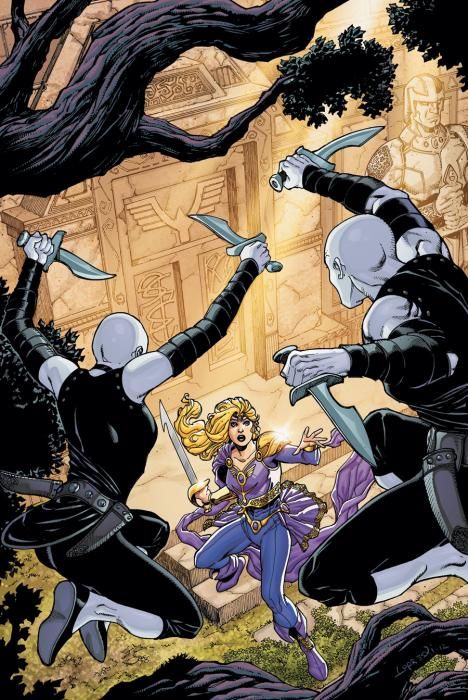In "Sword of Sorcery" #5, Christy Marx and Aaron Lopresti reveal new facets of palace intrigue and family history in "Vyrian's Tomb" and Marc Andreyko and Andrei Bressan have Stalker making a deal with Lucifer in "Soul to Soul."
The brief crossover of "Amethyst" with "Justice League Dark" ended up being a pointless if enjoyable detour. Marx picks up the plot at the same place it left off in "Sword of Sorcery" #3, as Amaya returns to Nilaa.
Lopresti's art is still excellent, and he creates an attractive new climate and architectural style for Akasa, the capital city of House Turquoise,
Hi-Fi's choice to make the flashbacks pale works well, and shadowy grays for a darkened tomb interior foreshadow the arrival of members of House Onyx.
Within "Vyrian's Tomb," a lot of Marx's long-foreshadowed plot points come to pass, such as Amaya finally learning more about her father and Mordiel's assassination attempt, yet on the page, the payoff feels strangely limp. The pacing is all wrong. Part of the problem is that Marx spends time re-treading the setup for these plot points in the opening pages. More about Amaya's father is revealed via a flashback that is an extended info-dump, and the assassination attempt is foiled by a plot development that is best described as a cheat.
The proliferation of powered gemstones, especially artifacts like "message gems" has been amusing, but in "Sword of Sorcery" #5, these coincidences or off-the-cuff explanations for how a gem can transfer portal energies or heal a dying woman are too much. While "Amethyst" needs an invented mythology, the way that Marx uses gems in "Vyrian's Tomb" is too convenient to be easily swallowed, and these plot crutches weaken the story and the reader's trust.
The biggest surprise in "Vyrian's Tomb" is old history between Lord Firojha and his son. The content itself is juicy, but Marx's timing of this revelation is too compressed. Gracial's accusation seems to come out of nowhere, especially since she has had ample time to confront Firojha in previous issues.
The most promising part of the plot is how a new character comes into play for House Turquoise in the ending scene. Marx's usually strong dialogue for Amaya is muted in "Sword of Sorcery" #5, but the new character already has a strong voice in how he affectionately calls his cat "Fuzzybutt."
In the backup story, "Soul to Soul," Stalker complete his deal with the devil, but reneges on it because, unsurprisingly, Lucifer has withheld crucial information. Here, the plot itself is nothing special. The devil is always a liar that gets the better end of any deal, and his motives seldom stray beyond biblical themes of mothers, children and the defiance of the Almighty. Also, it doesn't make sense that Stalker doesn't catch on when handed a photo but suddenly sees a resemblance when he's confronted with his quarry in the flesh.
Despite these caveats, Andreyko's dialogue, with its nice specificity of word choice, and Bressan's smooth panel-to-panel action make the action feel gripping and fresh. Chris Sotomayor's colors are intentionally garish and work well against Bressan's gritty inking style. I enjoyed Travis Lanham's lettering, with its Todd Kleinesque-script for Lucifer's words and Stalker's magicks.
"Vyrian's Tomb" lacks the emotional resonance of previous installments of "Amethyst," and its usual strengths of voice and world-building are diminished by poorly paced action. "Soul to Soul" has excellent pacing and thus becomes the stronger story fragment in "Sword of Sorcery" #5, showing neatly that plot execution can be more crucial than ideas.

